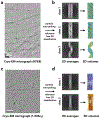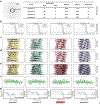Cryo-EM of Helical Polymers
- PMID: 35133794
- PMCID: PMC9357864
- DOI: 10.1021/acs.chemrev.1c00753
Cryo-EM of Helical Polymers
Abstract
While the application of cryogenic electron microscopy (cryo-EM) to helical polymers in biology has a long history, due to the huge number of helical macromolecular assemblies in viruses, bacteria, archaea, and eukaryotes, the use of cryo-EM to study synthetic soft matter noncovalent polymers has been much more limited. This has mainly been due to the lack of familiarity with cryo-EM in the materials science and chemistry communities, in contrast to the fact that cryo-EM was developed as a biological technique. Nevertheless, the relatively few structures of self-assembled peptide nanotubes and ribbons solved at near-atomic resolution by cryo-EM have demonstrated that cryo-EM should be the method of choice for a structural analysis of synthetic helical filaments. In addition, cryo-EM has also demonstrated that the self-assembly of soft matter polymers has enormous potential for polymorphism, something that may be obscured by techniques such as scattering and spectroscopy. These cryo-EM structures have revealed how far we currently are from being able to predict the structure of these polymers due to their chaotic self-assembly behavior.
Figures






Similar articles
-
Conventional Electron Microscopy, Cryogenic Electron Microscopy, and Cryogenic Electron Tomography of Viruses.Subcell Biochem. 2024;105:81-134. doi: 10.1007/978-3-031-65187-8_3. Subcell Biochem. 2024. PMID: 39738945 Review.
-
Structure of HIV-1 capsid assemblies by cryo-electron microscopy and iterative helical real-space reconstruction.J Vis Exp. 2011 Aug 9;(54):3041. doi: 10.3791/3041. J Vis Exp. 2011. PMID: 21860371 Free PMC article.
-
Automated structure refinement of macromolecular assemblies from cryo-EM maps using Rosetta.Elife. 2016 Sep 26;5:e17219. doi: 10.7554/eLife.17219. Elife. 2016. PMID: 27669148 Free PMC article.
-
Near-atomic-resolution cryo-EM for molecular virology.Curr Opin Virol. 2011 Aug;1(2):110-7. doi: 10.1016/j.coviro.2011.05.019. Curr Opin Virol. 2011. PMID: 21845206 Free PMC article. Review.
-
Sample preparation of biological macromolecular assemblies for the determination of high-resolution structures by cryo-electron microscopy.Microscopy (Oxf). 2016 Feb;65(1):23-34. doi: 10.1093/jmicro/dfv367. Epub 2015 Dec 15. Microscopy (Oxf). 2016. PMID: 26671943 Review.
Cited by
-
Archaeal bundling pili of Pyrobaculum calidifontis reveal similarities between archaeal and bacterial biofilms.Proc Natl Acad Sci U S A. 2022 Jun 28;119(26):e2207037119. doi: 10.1073/pnas.2207037119. Epub 2022 Jun 21. Proc Natl Acad Sci U S A. 2022. PMID: 35727984 Free PMC article.
-
Surfactant-like peptide gels are based on cross-β amyloid fibrils.Faraday Discuss. 2025 Aug 28;260(0):35-54. doi: 10.1039/d4fd00190g. Faraday Discuss. 2025. PMID: 40376775 Free PMC article.
-
Molecular architecture of the assembly of Bacillus spore coat protein GerQ revealed by cryo-EM.Nat Commun. 2024 Sep 16;15(1):8091. doi: 10.1038/s41467-024-52422-2. Nat Commun. 2024. PMID: 39284816 Free PMC article.
-
Two distinct archaeal type IV pili structures formed by proteins with identical sequence.Nat Commun. 2024 Jun 14;15(1):5049. doi: 10.1038/s41467-024-45062-z. Nat Commun. 2024. PMID: 38877064 Free PMC article.
-
Hierarchical Assembly of Intrinsically Disordered Short Peptides.Chem. 2023 Sep 14;9(9):2530-2546. doi: 10.1016/j.chempr.2023.04.023. Epub 2023 May 16. Chem. 2023. PMID: 38094164 Free PMC article.
References
Publication types
MeSH terms
Substances
Grants and funding
LinkOut - more resources
Full Text Sources

